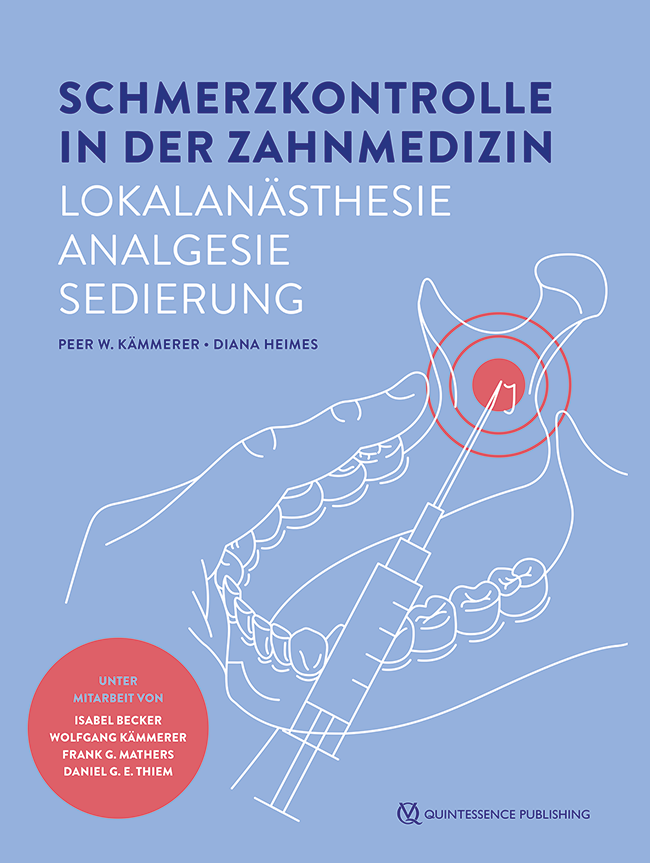Implantologie, 2/2025
Seiten: 189-200, Sprache: DeutschHeimes, DianaAls effektive Möglichkeit zur Schmerzausschaltung stellt die Lokalanästhesie eine fundamentale Säule in der Implantologie dar. Im vorliegenden Artikel werden die historischen Entwicklungen der Lokalanästhesie sowie deren Wirkmechanismen und Anwendungstechniken erläutert. Insbesondere werden primäre und sekundäre Anästhesieverfahren differenziert und inklusive ihrer Vor- und Nachteile beleuchtet. Aktuelle Trends wie die präemptive Analgesie und die Pufferung von Lokalanästhetika, welche die Wirksamkeit in schwierigen klinischen Situationen steigern können, werden diskutiert. Im Fokus stehen außerdem spezifische Herausforderungen in der Implantologie wie die Wahl der geeigneten Technik bei Implantationen im Unterkieferseitenzahngebiet sowie anatomische Variationen und deren Einfluss auf die Erfolgsrate. Der umfassende Überblick über den aktuellen Stand der Lokalanästhesie bietet praxisrelevante Erkenntnisse für Zahnmediziner und Implantologen.
Schlagwörter: Lokalanästhesie, Implantologie, Zahnmedizin, präemptive Analgesie, Pufferung von Lokalanästhetika, Vasokonstriktor
Quintessenz Zahnmedizin, 12/2024
Seiten: 989-994, Sprache: DeutschHeimes, Diana / Kämmerer, Peer W.Die Lokalanästhesie sollte individuell auf den Patienten abgestimmt werden. Der Begriff „Risikopatient“ umfasst nicht nur Menschen mit Vorerkrankungen, sondern auch Kinder, Schwangere und ältere Patienten. Liegen mehrere Erkrankungen vor oder nimmt der Patient mehr als 2 Medikamente ein, steigt das Risiko für Komplikationen signifikant an. Bis zu 44 % der Zahnärzte berichten von mindestens einer systemischen Komplikation pro Jahr, wobei 8 % schwerwiegender Natur sind. Über die Hälfte der betroffenen Patienten hat Begleiterkrankungen, vor allem kardiovaskuläre oder zerebrovaskuläre Beschwerden. Trotz der zunehmenden Zahl von Risikopatienten wird in der Praxis häufig hochkonzentriertes Adrenalin verwendet, obwohl oft geringere Dosen ausreichen. Eine Anästhesie ohne Vasokonstriktor ist bei korrekter Auswahl des Präparats ebenfalls möglich. Zudem können minimalinvasive Injektionstechniken das Risiko systemischer Toxizität zusätzlich verringern. Manuskripteingang: 17.09.2024, Manuskriptannahme: 24.09.2024
Schlagwörter: Lokalanästhesie, kardiovaskuläre Erkrankung, Diabetes mellitus, Lebererkrankung, Nierenerkrankung
International Poster Journal of Dentistry and Oral Medicine, 4/2022
Poster AwardPoster 2487, Sprache: EnglischHeimes, Diana / Schiegnitz, Eik / Kuchen, Robert Maximilian / Kämmerer, Peer Wolfgang / Al-Nawas, BilalBackground: Immediate dental implant placement has been a subject of great interest over the last decade. Here, information regarding the anatomy and bone thickness of the jaw prior to dental implant placement is crucial to increase the surgery’s success and the patient’s safety. The clinical premises for this approach have been controversially discussed. One of those heavily discussed premises is a buccal bone thickness of at least 1 mm thickness. This meta‐analysis aims to systematically review buccal bone thickness (BBT) in healthy patients. Thus, the feasibility of immediate dental implant placement in daily practice can be assessed.
Methods: A search in the electronic databases was performed to identify articles reporting on BBT that was measured by computed tomography in adults.
Results: We were able to find 45 studies, including 4324 patients with 25,452 analysed teeth. The analysis showed a BBT at the alveolar crest of 0.76 ± 0.49 mm in the maxillary frontal and of 1.42 ± 0.74 mm in the maxillary posterior region. In the mandible, the average measured values were similar to those in the maxilla (front: 0.95 ± 0.58 mm; posterior: 1.20 ± 0.96 mm). In the maxillary frontal region 74.4% and in the mandibular frontal region 61.2% of the crestal buccal bones showed widths <1 mm.
Conclusions: In more than 60% of the cases, the BBT at the alveolar crest is <1 mm in maxillary and mandibular frontal regions. This anatomic data supports careful pre‐surgical assessment, planning of a buccal graft, and critical selection of indication for immediate implant placement, especially in the maxillary and mandibular frontal and premolar region.
Schlagwörter: dental implant, tomography, dental implant loading, immediate, alveolar bone, buccal bone thickness
International Poster Journal of Dentistry and Oral Medicine, 4/2022
Poster AwardPoster 2489, Sprache: EnglischHeimes, Diana / Becker, Philipp / Thiem, Daniel G. E. / Kuchen, Robert / Kyyak, Solomiya / Kämmerer, Peer WolfgangBackground: This cross-sectional study aims to compare a new and non-invasive approach using hyperspectral imaging (HSI) with the conventional modified Allen’s test (MAT) for the assessment of collateral perfusion prior to radial forearm free flap harvest in healthy adults.
HSI of the right hand of 114 patients was recorded. Here, three recordings were carried out: (I) basic status (perfusion), (II) after occlusion of ulnar and radial artery (occlusion), and (III) after releasing the ulnar artery (reperfusion). At all recordings, tissue oxygenation/superficial perfusion (StO2 (0–100%); 0–1 mm depth), tissue haemoglobin index (THI (0–100)) and near infrared perfusion index/deep perfusion (NIR (0–100); 0–4 mm depth) were assessed. A modified Allen’s test (control) was conducted and compared with the HSI-results.
Results: Statistically significant differences between perfusion (I) and artery occlusion (II) and between artery occlusion (II) and reperfusion (III) could be observed within the population with a non-pathological MAT (each <0.001). Significant correlations were observed for the difference between perfusion and reperfusion in THI and the height of the MAT (p < 0.05). Within the population with a MAT >8 s, an impairment in reperfusion was shown (each p < 0.05) and the difference between perfusion and reperfusion exhibited a strong correlation to the height of the MAT (each p < 0.01).
Conclusions: The results indicate a reliable differentiation between perfusion and occlusion by HSI. Therefore, HSI could be a useful tool for verification of the correct performance of the MAT as well as to confirm the final diagnosis, as it provides an objective, reproducible method whose results strongly correlate with those obtained by MAT. What is more, it can be easily applied by non-medical personnel.
Schlagwörter: hyperspectral imaging, Allen’s test, radial forearm free flap, microvascular surgery, microsurgery, reconstructive surgery, perfusion monitoring, flap imaging
International Poster Journal of Dentistry and Oral Medicine, 1/2022
Poster 2439, Sprache: EnglischHeimes, Diana / Müller-Heupt, Lena Katharina / Schellin, Alexandra / Naujokat, Hendrik / Graetz, Christian / Goedecke, Maximilian / Beck-Broichsitter, Benedicta / Kämmerer, Peer WolfgangBackground: In response to the global COVID-19 pandemic, governmental measures have been undertaken. The impact of the crisis on the healthcare of patients with cancer is largely unexplored. This multicenter cohort study aimed to investigate a potential screening delay and its consequences in patients with oral cancer (OC) during the pandemic.
Material and Methods: Data of patients who were first diagnosed with OC during different periods were collected, especially in terms of OC incidence, tumor stage/entity, and time to intervention. The lockdown (LD) (13 March–16 June 2020) and post-lockdown (PLD) (17 June–1 November 2020) periods and the corresponding equivalents in 2018/19 were differentiated and compared.
Results: There was no obvious trend towards a higher incidence of OC or higher tumor stages, whereas a trend towards a shorter time to intervention during the LD2020 could be observed. Subgroup analyses revealed an increased incidence in OC within the PLD2020 in Mainz, which might be explained by the partial closure of dental practices in this federal state during LD.
Conclusions: While there was no overall higher incidence of OC, we found closure of practices during LD possibly delay cancer diagnosis. Therefore, measures must be taken to identify patients at risk and to ensure basic healthcare, especially in the context of dental screening measures.
Schlagwörter: COVID-19, SARS-CoV-2, oral cancer, oral malignant lesions, screening; precursor lesions, lockdown, pandemic, head and neck cancer, HNSCC




